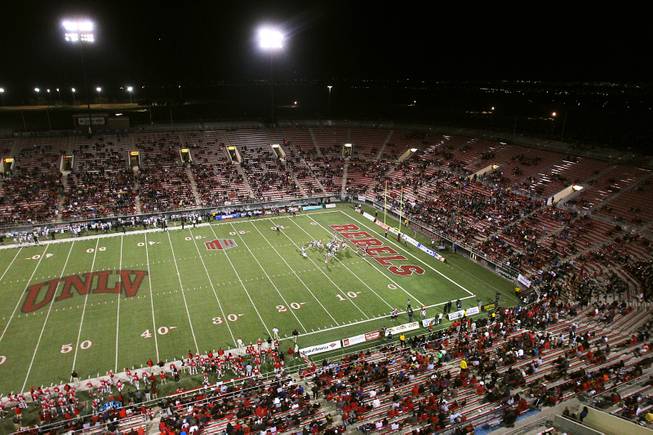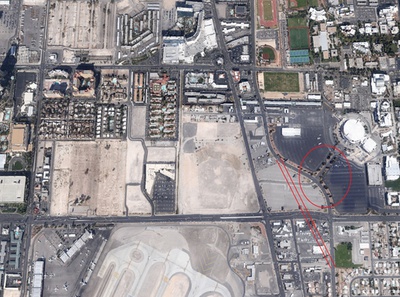
UNLV takes on Utah State on Saturday, Nov. 9, 2013, at Sam Boyd Stadium. The university is working to enhance the game-day experience.
Thursday, June 19, 2014 | 3:56 p.m.
UNLV’s proposed new football stadium could add between $231 million and $511 million in direct spending to the Las Vegas economy each year, if it’s built, according to the university’s stadium consultants.
Conventions, Sports and Leisure International, assisted by local financial firm RCG Economics’ John Restrepo, presented its economic impact study to UNLV’s Campus Improvement Authority Board today.
The university hopes to build a 50,000-seat stadium closer to its main campus to host UNLV football games and other events that could drive tourism to the nearby Las Vegas Strip.
An open-air stadium could have a $231 million annual direct economic impact on Southern Nevada, including the addition of 2,399 jobs. A domed stadium could have a $511 million annual economic impact, including 5,342 jobs.
Direct spending includes revenue from ticket sales, wages and taxes generated from an estimated 27 events at the stadium each year.
Indirect spending, which includes ancillary economic activity from food services, transportation, utility and other outside companies connected to the stadium, could add between $113 million and $251 million to the stadium’s total economic impact.
The projections, however, come as UNLV struggles to find funding sources for construction and a location for the stadium. Without them, the project is dead in the water.
CSL International is looking at 16 public and private funding sources.
Private sources include naming rights, advertising and sponsorships, premium seating, equity, seat licenses, donations and profits generated from the stadium.
Public sources include a sales tax on the Strip and in Clark County, a hotel tax, car rental tax, live entertainment tax, income tax, property tax, business tax and a slot tax.
But UNLV must compete with other major projects for public funding.
Don Snyder, UNLV’s president and stadium authority board chairman, said a sales tax may be the “only logical alternative” for the project since the resort industry is eying the hotel room tax for its $2.5 billion Las Vegas Convention Center renovation .
Several resort industry officials on the UNLV stadium authority board balked at the list of taxes suggested to pay for the stadium. Some questioned why tax dollars are being considered at all.
“I don’t support the use of public funds,” said Paul Chakmak, executive vice president and chief operating officer of Boyd Gaming. “The state and the county have fiscal needs. To prioritize a stadium ahead of those seems like it’s not the right place. We all have to be responsible.”
Kim Sinatra, senior vice president and general counsel for Wynn Resorts, said, “A billion dollars is a lot of money. If we want to spend a billion dollars on UNLV, is it a stadium?”
After three years of negotiating with Federal Aviation Administration and McCarran International Airport representatives, UNLV officials acknowledged last week that the site it initially identified for a new stadium — northeast of Swenson Street and Harmon Avenue — is not feasible because it would interfere with airport activity.
UNLV is looking for alternatives on and off campus. The university hired an engineering firm, Kimley Horn, to study other potential sites, including the parking lot of the Thomas and Mack Center.
The proposed on-campus site next to the Thomas and Mack would present new challenges and opportunities, said Gerry Bomotti, UNLV’s senior vice president of finance and business.
While athletic events would be concentrated on that corner of campus, traffic and parking could be a nightmare. Furthermore, Swenson Street would have to be realigned to the southwest, which would displace businesses and a U.S. Post Office in the area.
“This raises as many questions as it resolves,” Bomotti said.
But Snyder said an on-campus stadium is paramount for the future of UNLV. He tied the stadium project to UNLV’s larger aspiration of becoming a top-tier research university with a strong campus spirit tied to academics and athletics.
“We have a broader vision to where the university is and where it’s going,” Snyder said. “This (stadium) is one part of the puzzle.”


Join the Discussion:
Check this out for a full explanation of our conversion to the LiveFyre commenting system and instructions on how to sign up for an account.
Full comments policy